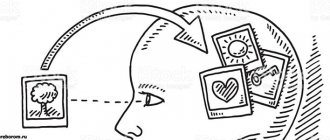Introduction
Body language is a language that almost everyone understands. Usually this happens completely unconsciously, without thinking. Body language is a signal that is transmitted from one person to another, which is why scientists also call this communication “non-verbal communication.” During intimate contact, a glance and touch are more expressive and provide more complete information than many words.
The language of body movements was very important already in Ancient Greece. For example, great importance was attached to posture. A man must hold his head high, otherwise he may be mistaken for a homosexual. Women and children, on the other hand, should not look the other person directly in the eyes. The casual look showed shyness, modesty and submissiveness.
In the XVII-XVIII centuries. In Western countries, books of the century were published on the rules of good sound. For example, in 1735, S. Van Par's book “The Great Ceremonial Book of Good Manners” was published, containing 500 pages.
The first book entirely devoted to gestures was the work of D. Balver “Chirology: either the natural language of the hand and chironomy, or the art of rhetoric of the hands.” And Francis Bacon even proposed creating a science of gestures. In the late 19th century, gestures were studied by anthropologists and psychologists.
In 1939, a three-volume monograph by I.A. appeared in Russia. Sobolevsky, in which the author presented his view on nonverbal communication.
Research into the meaning of human body language continues, as evidenced by international conferences and scientific reports, for example, the collection “Gestures and Moods from Antiquity to the Present,” published in England.
The Psychology of Lying Paul Ekman
It is known that the prototype of the main character, Cal Lightman, and also the consultant of the series was psychology professor Paul Ekman.
Paul Ekman (born February 15, 1934) is an outstanding American psychologist, professor at the University of California at San Francisco, a leading expert in the field of psychology of emotions, interpersonal communication, psychology and lie detection. In 2009, Time magazine included Paul Ekman in the list of 100 the most influential people in the world. Paul Ekman has devoted more than 30 years to studying the theory of lies and is one of the best specialists in this field.
Its services are used not only by leading politicians, entrepreneurs, and executives, but also by various ministries and agencies of the US federal government.
Currently, Paul Ekman heads the Paul Ekman Group, a small company that develops methods and educational devices in the field of studying emotions and microexpressions.
Paul Ekman was educated at the University of Chicago and New York University. He received his PhD (in clinical psychology) from Adelphi University (New York) in 1958, after which he worked at the Langley Porter Neuropsychiatric Institute. Then, after serving two years in the US Army as a clinical psychology officer, Ekman returned to Langley Institute, where he practiced from 1960 to 2004.
The study of facial expressions and body language began in 1954 as the subject of his scientific practice (1955) and first publication (1957).
Over the next 10 years, his work focused on social psychology and cultural differences, and his interest in semiotics intensified. In parallel with his studies of human emotions and expressions, Paul Ekman began to actively work on the study of the theory of deception.
In 1971, Paul Ekman was awarded the National Institute of Mental Health's Research Achievement Award. He later received this award in 1976, 1981, 1987, 1991 and 1997. The National Institute of Mental Health continued to support Ekman's research with fellowships, grants and awards for 40 years.
Paul is the author of over 40 books - “Face of Man” (1980), “Telling Lies” (three times reprinted), “Why Kids Lie” (1989), “Emotions Revealed” (2003),
"Telling Lies, Dalai Lama-Emotional Awareness" (2008) and "New Edition Emotions Revealed" (2007).
There are also publications in Russian:
- Why children lie. 1993
- Wisdom of East and West. Psychology of balance.2010
- Know a liar by his facial expression.2010
- Psychology of lies. Fool me if you can. — 2nd edition.2010
- Psychology of emotions. I know what you feel. 2nd edition.2010
He is also the author of more than 100 articles.
4 pp., 1912 words
Unresolved problems in the psychology of emotions
... this is the crux of the problem. When characterizing the unresolved problems of the psychology of emotions, one should obviously begin with the object of research. In modern psychology of emotions there is no clear definition of the object of research, because ... they ensure their implementation. An equally important unresolved issue in the general psychology of emotions is the issue of classification of emotional phenomena. The generally accepted division of emotional phenomena into...
Nonverbal Communication
Research has shown that only one tenth of the information a person provides is verbal information. The rest comes from gestures, facial expressions, pantomime, eye contact, touch and intonation. The first intuitive “scanning” of a person takes about 20 seconds. People don't always say what they mean, but the body can't lie. Hidden feelings find their way through gestures. The psychology of nonverbal communication is very broad and complex. Once you learn to understand human gestures and their meaning, it will be much easier for you to know the truth.
When a person’s emotional background increases, he stops paying attention to his body. But when trying to untangle someone else's thoughts, situational factors must be taken into account in order for the judgment to be correct. For example, if a person crosses his arms over his chest in severe frost, this can only mean that he is cold, that he is not closed and not closed.
Let's consider nonverbal means of communication.
Errors in nonverbal communication
You don’t need to know what nonverbal communication is to notice unconscious signals in the behavior of your interlocutor. But controlling yourself, avoiding unwanted gestures and facial expressions, is much more difficult. Therefore, it is advisable to remember the main mistakes and regularly remind yourself that they cannot be repeated. Most often we are talking about such non-verbal signals as:
- Hidden palms. If a person hides his palms, it seems that he is afraid of something or that he is speaking insincerely. No, you don’t need to demonstratively turn your palms towards your interlocutor. Just keep your hands visible, don't clench them into fists or hide them in your pockets.
- Averted gaze. When the interlocutor looks away, it seems as if he is not sincere enough. You can only look away when there is a reason for it. For example, if you're having lunch and socializing, there's nothing wrong with periodically looking at your plate.
- Sagging posture, hunched shoulders. This is usually what very tired or unconfident people look like. Therefore, regardless of your health and mood, make sure that your back is always straight and your shoulders are straight.
- Invasion of someone else's personal space. The width of your comfort zone varies from person to person. For example, for a person who grew up in a village, it is much wider than for a city dweller. Always keep in mind that your interlocutor may be uncomfortable if you get too close to him.
- Touching the face, ears, neck and hair. Touching different parts of the body often signals hidden feelings. In addition, a person who is constantly fussing looks insecure. Try to always sit straight and calm, and if you want to correct something, it is better to do it openly (for example, by looking in the mirror), rather than furtively.
Gestures
Gestures are a lot of hand and head movements. Sign language is the oldest way to mutual understanding. In different historical eras and among different peoples they had their own common way of gesturing.
The intensity of gestures can increase as a person's emotional arousal increases, and also when you want to achieve better mutual understanding between partners, especially when this is difficult.
The specific meaning of individual gestures varies among cultures.
However, all cultures have the same gestures, which we can differentiate between:
- communicative (gestures of greeting, farewell, attracting attention, prohibitions, affirmation, denial, interrogation, etc.).
- modality, i.e. expression of assessment and attitude (gestures of agreement, satisfaction, trust and mistrust, etc.).
- descriptive gestures that make sense only in the context of speech.
Gestures can be open and closed. Overt gestures include movements in which a person places their arms to the side or shows their palms. They indicate that a person is open and ready to communicate. Closed gestures include those that help a person create a psychological barrier. The body can be covered not only by hands, but also by foreign bodies. Such manipulations indicate that the person does not trust the interlocutor and is not ready to open up to him. These can be “closed” fingers or crossed arms.
Structure, functions, types of communication
Communication - interactions and relationships that arise between various subjects: between individuals, an individual and a group, an individual and society, a group and society.
In the last decades of the last century, the problem of communication was the “logical center” of psychological science. The study of this problem has opened up the possibility of a more in-depth analysis of psychological patterns and mechanisms for regulating human behavior, the formation of his inner world, and has shown the social conditioning of the individual’s psyche and lifestyle.
Psychological analysis of communication reveals the mechanisms of its implementation. Communication is put forward as the most important social need, without the implementation of which the formation of personality slows down and sometimes even stops.
Psychologists consider the need for communication to be one of the most important conditions for personality formation. In this regard, the need for communication is considered as a consequence of the interaction of the individual and the sociocultural environment, and the latter simultaneously serves as the source of the formation of this need.
Since man is a social being, he constantly feels the need to communicate with other people, which determines the potential continuity of communication as a necessary condition for life.
Empirical data indicate that from the first months of life a child has a need for other people, which gradually develops and transforms - from the need for emotional contact to the need for deeply personal communication and cooperation with adults. At the same time, the ways to satisfy this basic need for each person are individual in nature and are determined both by the personal characteristics of the subjects of communication, the conditions and circumstances of their development, and by social factors.
Communication can be: communicative, interactive and perceptive. The communicative side of communication consists of the exchange of information between communicating individuals. The interactive side consists in organizing interaction between communicating individuals, i.e. in the exchange of not only knowledge, ideas, but also actions. The perceptive side of communication means the process of perception and knowledge of each other by communication partners and the establishment of mutual understanding on this basis.
The functions of communication are diverse - in accordance with a wide range of practical problems solved during business negotiations, conversation, dialogue, etc. The generalized grouping of functions allows for the identification of three varieties.
The communicative function is realized as the transmission and reception of messages and knowledge (from person to person, from generation to generation, from culture to culture, etc.).
The regulatory function “manages” the process of communication between people, during which goals, motives, and guidelines for future joint or individual activities are clarified and formed. This function constantly provides feedback on the statements of your interlocutors.
The emotional-psychic function manifests itself as the creation of a complex of feelings and mental states of each interlocutor during communication. Emotions can give additional meaning and weight to the most ordinary words. Each dialogue, each conversation, perceived by the interlocutors as a need to “vent their souls,” speak out, etc., ultimately leads to a special emotional uplift (catharsis), i.e. to satisfaction with communication. And on the contrary: negative emotions that arise during a conversation can “prematurely” break off a business contact. nonverbal means of communication facial code
Depending on the content, goals and means, communication can be divided into several types.
In terms of content, it can be: material (exchange of objects and products of activity), cognitive (exchange of knowledge), conditional (exchange of mental or physiological states), motivational (exchange of motives, goals, interests, motives, needs), activity (exchange of actions, operations , abilities, skills).
According to the goals, communication is divided into: biological (necessary for the maintenance, preservation and development of the body), social (pursues the goals of expanding and strengthening interpersonal contacts, establishing and developing interpersonal relationships, personal growth of the individual).
By means of communication, communication can be: direct (carried out with the help of natural organs given to a living being - arms, head, torso, vocal cords, etc.), indirect (associated with the use of special means and tools), direct (involves personal contacts and direct perception of each other by communicating people in the very act of communication), indirect (carried out through intermediaries who can be other people).
Communication as interaction presupposes that people establish contact with each other, exchange certain information in order to build joint activities and cooperation.
Pantomime
Facial expression is the movement of facial muscles, the main indicator of emotions. Studies have shown that when the interviewer's face is silent or invisible, up to 10-15% of information is lost. There are more than 20,000 descriptions of facial expressions in the literature. The main characteristic of facial expressions is their integrity and dynamism. This means that in the facial expressions of the six main emotional states (anger, joy, fear, sadness, surprise, disgust - see Appendix No. 1), all movements of the facial muscles are coordinated. The main information load in facial expressions is carried by eyebrows and lips.
Content
- Introduction……………………………………………………………………………….3
- Psychology of lies……………………………………………………………4
- Paul Ekman is a leading scientist in the field……………….4
- Microexpressions and microgestures…………………………………6
- “I read your faces”……………………………………………8
- Words…………………………………………………………….10
Pantomime
Pantomime is gait, posture, general motor skills of the whole body.
Gait is the way a person moves. Its components: Rhythm, step dynamics, amplitude of body transmission during movement, body weight. By gait you can judge a person’s well-being, character, age, and recognize emotions such as anger, suffering, pride, and happiness. It turned out that a “stiff” gait is typical for people who are angry, while a “light” gait is typical for happy ones.
Position is the position of the body. The human body is capable of taking about 1000 stable different positions. Posture shows how a person perceives his status in relation to the status of others present. People with higher status adopt a more relaxed posture. Otherwise, conflict situations may arise.
The most important semantic content of the pose is to position the body in relation to the interlocutor. This position indicates either a closed position (face with arms and legs crossed) or a communication position.
A closed position is perceived as a position of distrust, disagreement, opposition and criticism. Moreover, the interlocutor did not assimilate about a third of the information received from this pose. The easiest way to come out of this position is to offer something to hold or observe.
The open position is a position in which the arms and legs are uncrossed, the body is directed towards the communication partner, and the palms and feet are turned towards the communication partner. This is a pose of trust, harmony, goodwill and psychological comfort.
If a person is interested in communication, he will focus on the interlocutor and lean back, and if he is not very interested, then, on the contrary, he will focus on the interlocutor and lean back. A person who wants to make a statement will be upright, tense, with shoulders turned; a person who does not need to emphasize his status and position will be relaxed, calm, in a free, relaxed position.
The best way to communicate with your interlocutor is to copy his posture and gestures.
Deception Detection Words
Surprisingly, many liars are exposed by careless statements. It’s not that they were unable to express their thoughts in any other way or that they tried but failed, no, they simply did not consider it necessary to carefully choose their words.
The head of an executive search firm told of a man who contacted his agency twice in one year under two different names. When this man was asked what name to call him, he “first called himself Leslie D'Ainter, and then Lester Dainter, lied without hesitation, explaining that he changed his name because Leslie was too similar to a girl’s name, and the surname for ease of pronunciation . But the reviews from his previous employers gave him away. He submitted three glowing letters of recommendation; and in all three his name was written differently.”
Voice
The voice is even more important than words in characterizing human speech. Here, the most common signs of deception are pauses. Pauses may be too long or too frequent. Hesitations before words, especially if this occurs when answering a question, always lead to suspicion. Short pauses during speech itself are also suspicious if they occur too often. Speech errors can also be signs of deception: interjections, for example “um”, “well” and “uh”; repetitions, such as “I, I, I mean that I...”; extra syllables, for example “I really liked it.”
These vocal signs of deception—speech errors and pauses—can occur for two related reasons. The liar did not think through his line of behavior in advance. If he did not expect to have to lie, or was prepared for this, but did not anticipate any specific question, he may hesitate or make speech errors. But this can also happen when the liar has prepared well. A strong fear of discovery can make even a trained liar stumble and even forget a well-thought-out line of behavior. Fear of discovery exacerbates the mistakes of an ill-prepared liar. When he hears how implausible his lies sound, he becomes even more afraid of being caught, resulting in an increase in the number of pauses and speech errors.
Eye contact
Eye contact is also an extremely important element of communication. Looking at the speaker, we can not only feel interested, but also focus on what we are being told. People interacting usually do not look each other in the eyes for more than 10 seconds. If we are not given enough attention, we have reason to believe that we or what we say is being treated poorly, and if we are paying too much attention, it may be perceived as a challenge or good treatment. Additionally, it has been observed that when a person is lying or trying to hide information, their eyes meet their partner's eyes less than 1/3 of the time they speak.
Appearance can be: business, social, intimate, with crossed eyes.
Plastic
Even during an experiment conducted more than 25 years ago, when I was a student, I learned that body movements also provide information about hidden feelings. I came up with an experiment to demonstrate that stress changes the eraser. The source of stress was our senior teacher, who agreed, sticking to the plan I had come up with, to conduct a survey among my fellow students on a topic that worried us all at the time. The teacher asked aspiring psychologists about what they were going to do after finishing their training, and everything that happened was filmed with a hidden camera. He attacked those who preferred scientific work for trying to hide in the laboratory from their responsibility to help sick people in need. He criticized those who were planning to engage in psychotherapy, accusing them of striving to “make money” and evading their responsibility to seek cures for mental illness by engaging in scientific work. He also asked if the student had ever been treated by a psychotherapist. Those who said “yes” were asked how they were going to help others if they themselves were sick. Those who had never sought help from psychotherapists were attacked, claiming that one could not counsel others if one had never consulted oneself. Not a single student should have emerged victorious from this situation. To make matters worse, I asked the teacher to interrupt the students, not to give them the opportunity to fully respond to any of his caustic remarks. I watched the experiment through a mirrored window and directed the camera so that it would continuously record body movements. I simply couldn’t believe my eyes when I saw the reaction to the first question. After the third attack from the teacher, one student showed him the finger (see Figure 1)! She held her hand in this position for almost a full minute. However, she did not look furious, and the teacher acted as if he had not seen anything. When the conversation ended, I rushed inside. Both of them said that these were my inventions. The girl admitted that she was angry, but denied that she had even expressed it in any way. The teacher also thought that I must have imagined it, because, he said, he could not help but notice the obscene gesture. After developing the film, I received proof. This reservation in the gesture (finger extended) was evidence of a non-unconscious feeling. She knew that she was furious, but only the expression of this feeling was unconscious. She didn't realize she was giving him the finger. The feelings that she deliberately tried to hide came out on their own.
Touch and Setting Characteristics
The role of contact in nonverbal communication. Here handshakes, kisses, caresses, strokes, blows, blows, etc. stand out. The use of contact in communication is determined by many factors: the status of the partners, their age, gender, degree of acquaintance.
Inappropriate use of a person's sense of touch can lead to communication conflicts. For example, patting on the back is possible only if the relationship is close and the social situation in society is the same.
During communication, it is also important to pay attention to voice characteristics associated with nonverbal communication: tone, volume of the voice, its timbre, its involvement in pauses in speech and various non-morphological human phenomena: crying, coughing, laughter, sighs, etc.
It is necessary not only to be able to listen, but also to hear the intonation system of speech, to appreciate the strength and tone of the voice, the speed of speech, which practically allows you to express your feelings and thoughts.
Voting contains a lot of information about the owner. An experienced voice expert can determine the age, place of residence, health, character and temperament of its owner.
Since the characteristics of the voice depend on the functioning of various organs of the body, it also reflects their condition. Emotions change the rhythm of breathing. Fear, for example, paralyzes the larynx, the vocal cords become tense, and the voice “sits down.” When the mind is well disposed, the voice becomes deeper and richer in shades. It has a calming effect on others and instills more confidence.
Microexpressions and microgestures
His most famous book “Telling Lies” (Russian edition - “Psychology of Lies”) sets out the theory of detecting deception using micro-expressions, voice changes, vegetative signs (blush, sweat, rapid breathing), a lie detector, etc. Mary’s story , presented in the series as the story of the suicide of Cal Lightman’s mother, actually happened in reality and it was this case in psychiatric practice that served as the beginning of Paul Ekman’s research activities. In the book, he writes:
“Mary is a housewife and is 42 years old. Of the three suicide attempts, the last one was quite serious; By pure chance, she was discovered before she could die from an overdose of sleeping pills. Her story is no different from many other women going through a midlife crisis. The children grew up and no longer needed her. The husband seemed immersed in his work. Mary felt unwanted. At the time of admission to the clinic, she suffered from insomnia, could no longer do housework, and cried most of the time. For the first three weeks, she was prescribed medication and group psychotherapy. After this, she seemed to begin to look better: she perked up and no longer talked about suicide. In one of the conversations we filmed, Mary told the doctor that she was feeling much better and asked to be allowed to go home for the weekend. However, when she was about to be released, she unexpectedly admitted that she had lied in order to get out of the hospital, since she still desperately wanted to end things with myself. After three months in the clinic, Mary's condition did improve, although a year later there was another relapse. However, she no longer required hospital treatment and appeared to do well in the following years. The videotape of the conversation with Mary fooled most of the young and even many experienced psychiatrists and psychologists to whom I showed it.
We studied the film for hundreds of hours, playing it over and over again, watching every gesture and facial expression in slow motion to identify every possible sign of deception. And in the short pause that arose before answering the doctor’s question about her future plans, we noticed a glimpse of despair on the patient’s face, so fleeting that we missed it when we watched the film the first few times. We had the idea that hidden feelings could manifest themselves in such short microexpressions ,
and we began to look for them and found many other microexpressions, usually instantly covered with a smile.
We were also able to identify microgestures .
When telling the doctor how well she was coping with her problems, Mary sometimes shrugged her shoulder slightly, it was just a fragment of the gesture, part of it: she slightly raised one arm, turning it a little. Or her hands were calm, but for a moment one shoulder rose.”
A microexpression is a short, involuntary facial expression that appears on the face of a person trying to hide or suppress an emotion. Microexpressions are not amenable to conscious control, that is, they appear regardless of a person’s desire. To an inexperienced observer, microexpressions are usually invisible, lasting from 1/25 to 1/5 of a second, while macroexpressions last from 1 to 10 seconds.
All facial expressions were studied and collected into a large scientific work.
The Facial Action Coding System (FACS) is a system for classifying human facial expressions originally developed by Paul Ekman and Wallace Friesen in 1978. It is a common standard for systematically classifying physical expressions of emotion and has proven useful for psychologists and animators.
The SKLiD manual covers more than 500 pages and provides a detailed description of motor units and descriptors.
While motor units are independent of any interpretation, they can be used for any higher order decision making, including emotion recognition.
With its help, you can determine any emotions, for example, anger, contempt, sadness, happiness, fear, surprise. You can also understand whether a person is smiling sincerely or not.
With a sincere, genuine smile, wrinkles form in the corners of the eyes. Insincere people smile only with their lips.
Bibliography
- Ekman P. Psychology of lies. Fool me if you can. — 2nd edition. - St. Petersburg: Peter, 2010. - 304 p. — ISBN 978-5-49807-580-8. - (Himself a psychologist.)
- Ekman P. Psychology of emotions / trans. from English V. Kuzin. - St. Petersburg: Peter, 2010. - 336 p. — ISBN 978-5-49807-705-5.
- Gorelov I. N.: Nonverbal components of communication. - M.: “Nauka”, 1980. - 238 p.
- Bagdasarova N. A.: Nonverbal forms of expression of emotions in the context of different cultures: universal and national // Materials of the interuniversity seminar on linguistic and cultural studies. MGIMOFA RF, 2006. - MGIMO-University, 2006.
- Birkenbill V.: The language of intonation, facial expressions, gestures. - S.-P.: "Peter", 1997. - 176 p.
Application
Fig.1
Examples of similar educational works
Psychology of lies and deception
... a person believes or thinks one thing, but expresses another in communication. 1 I. Vagin’s book “Psychology of Survival in Modern Russia” examines the problems of deception ... Professor of Psychology at the University of California at San Francisco Paul Ekman “Psychology of Lies” ...
Communication as a means of interaction with people
... and facial expression. This is called body language. When you first look at a person, you immediately notice his facial expression and... skill (non-verbal communication), and explain what you are doing (verbal communication). Verbal Communication Verbal communication consists of...
Study of emotions in domestic psychology
...functions of emotions, their influence on human life. In sports psychology, about the influence of emotions... expression of emotions, the influence of individual emotional states on activity, which ensure the development of the experiment. Accordingly, the concepts of emotions...
The problem of emotions in domestic psychology
... a person to the world, to what he experiences and does, in the form of direct experience” (S.L. Rubinstein). In this test, I will dwell in detail on the problem of emotions in Russian psychology, ... of this object or person, experiencing those ...
Topic 2. Man in the mirror of economics and psychology. Psychological determinants of behavior...
... approach in psychology: “A person before ... participants in communication occupies before ... a person, like gender and age characteristics, inclinations, abilities, temperament, memory, emotions, ... people of a developed society. But, noting the diversity of individual business entities...





